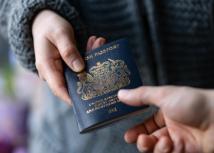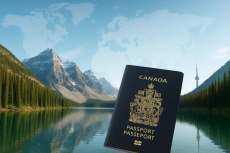Blog • Published on:November 14, 2025 | Updated on:November 14, 2025 • 12 Min
Why More Families Are Choosing Impact-Driven Citizenship in 2025
Second citizenship is still about mobility, resilience, and long-term security.
But today, many investors have added a new filter: meaning.
They are no longer asking only “Where can I go?” They are asking: “If I am contributing to this country, what exactly am I building with my money?”
This is where impact-driven citizenship comes in. It is not a separate product category. It is a way of choosing programs based on what your investment enables, not only the passport you receive.
What Exactly Is Impact-Driven Citizenship Investment?
Short answer:
Impact-driven citizenship means selecting a citizenship-by-investment route based on the real national projects your contribution supports, such as healthcare, climate resilience, education, and infrastructure, rather than focusing only on visa-free access or speed.
Instead of asking, “Which passport is cheapest or fastest?”, impact-driven investors ask:
- What does my contribution fund?
- How transparent is the use of funds?
- Does this program have long-term credibility?
How Do Investors Evaluate Impact-Driven Programs in Practice?
Most serious applicants now look at three dimensions.
1. Does the Investment Support Real National Development?
Impact-oriented CBI programs explicitly channel contributions into:
- Climate-resilient and social housing
- Healthcare facilities and equipment
- Education and skills development
- Core infrastructure (roads, utilities, community projects)
- Economic diversification (tourism, agriculture, services)
2. Is the Use of Funds Transparent and Trackable?
Credible programs provide:
- Clear description of the national fund
- Stated priority sectors (e.g. housing, healthcare, education)
- Government oversight and reporting on how funds are used
- Increasingly, public communication on key completed projects
This transparency supports both investor confidence and long-term program stability.
3. Does the Program Have Long-Term Credibility?
Programs that channel funds into serious development tend to:
- Maintain strict due diligence
- Sustain international recognition
- Avoid abrupt, reactive changes
- Attract more stable demand over time
In other words, development-focused programs are usually the ones that last.
What Are the Typical Contribution Levels for Impact-Driven Citizenship in 2025?
What Are the Key Impact-Linked Funds and Their Current Contribution Levels?
Direct answer:
Impact-linked citizenship donations typically start around $90,000–200,000, with most core programs in the $200,000–240,000 range for a single applicant, depending on the fund and jurisdiction.
Who Is Eligible for These Impact-Driven Citizenship Programs?
Short answer:
Most impact-focused CBI programs are open to financially sound applicants with a clean background, verifiable funds, and eligible dependants, subject to each country’s rules.
Typical baseline criteria include:
- Clean criminal record
- Verified legal source of funds
- No international sanctions or serious compliance flags
- Good general standing (no major unresolved legal cases)
- Ability to meet the required contribution + fees
Which Family Members Can Usually Be Included?
While details vary by country and should always be date-stamped, many programs allow:
- Spouse
- Children (up to a specified age, often 25, if dependent)
- Parents and/or grandparents (if financially dependent or meeting set conditions)
Because family structures and age caps change, eligibility should always be checked against current government regulations at the time of application.
How Do These Programs Typically Work in Practice?
- Processing time: usually around 3–6 months once documents are complete
- Physical presence: often no residency requirements
- Main structure: contribution to a national fund + due diligence + government approval
- Impact dimension: contribution is ring-fenced or directed into identified national priorities
What Benefits Do Purpose-Driven Citizenship Programs Offer in 2025?
Why Are Investors Prioritising “Impact” Instead of Only Mobility?
Short answer:
Because impact-driven programs let investors secure mobility and long-term protection while directly contributing to real national progress, from healthcare upgrades to climate resilience and education.
Impact gives the investment meaning, and meaning gives the program credibility.
Below are the core benefits investors evaluate today, backed by real examples from current jurisdictions.
1. How Do These Programs Create Social Impact That Actually Matters?
Direct answer:
Impact-driven programs fund visible national improvements, housing, public facilities, healthcare, utilities, education, not theoretical or symbolic projects.
Examples of observable social impact:
- Dominica: CBI contributions rebuilt thousands of homes and community buildings after Hurricane Maria, including fully climate-resilient developments.
- Antigua: Social-development allocations have supported community services, utilities upgrades, and expansion of the University of the West Indies campus.
- Grenada: A portion of the National Transformation Fund supports local employment projects tied to tourism and agriculture.
These are nation-level improvements backed by real expenditure reports, not “expected” impact.
2. How Do These Programs Support Environmental and Sustainability Priorities?
Direct answer:
Several countries channel citizenship revenue into climate resilience, renewable energy, and environmental restoration because these are national survival priorities.
Examples:
- Dominica: Climate-resilient housing, coastal reinforcement, watershed protection, and emergency-shelter construction.
- St. Lucia: NEF-funded agriculture restoration, environmental management systems, and resilience infrastructure.
- Grenada: Eco-focused tourism developments and environmental protection for marine and coastal zones.
These projects directly reduce climate vulnerability, critical for island economies.
3. How Does Impact-Driven Citizenship Support National Economic Growth?
Direct answer:
Well-managed CBI revenue strengthens economic stability by funding sectors that produce jobs, diversify income, and reduce reliance on external borrowing.
Key economic contributions:
- Tourism development: Hotels, resorts, and tourism infrastructure generate employment and foreign currency.
- Agriculture and food security: Funded upgrades support local farmers and national supply chains.
- Healthcare capacity: Investments reduce national pressure and improve productivity.
- Digital transformation: Increasingly prioritised for efficient governance and service delivery.
When national systems strengthen, the long-term credibility of the passport also strengthens.
4. Do Any Programs Support Cultural Heritage Preservation?
Direct answer:
Yes. Some programs invest directly into national heritage, restoration work, and cultural institutions that strengthen national identity.
Examples:
- Antigua and Barbuda: CBI funds contribute to preserving UNESCO-listed heritage sites such as Nelson’s Dockyard.
- Grenada: Restoration and protection of historical estates and cultural landmarks via tourism and heritage projects.
- Dominica: Investments in preserving indigenous Kalinago community infrastructure and cultural assets.
This links the investor’s contribution to the country’s historical continuity.
5. Why Do Families Consider Impact-Driven Programs More Aligned with Their Values?
Direct answer:
Because families want their citizenship choice to support education, healthcare, long-term stability, and a positive future for the country they join.
Most families today, especially with children, care about:
- Education infrastructure
- Healthcare capacity
- Community development
- National resilience and safety
Impact-driven programs directly fund these areas, creating a long-term alignment between the investor’s values and the nation’s progress.
Benefit Summary
What Features Define an Impact-Driven Citizenship Program?
What Makes an Impact-Driven Program Different from a Donation Route?
Direct answer:
Impact-driven programs clearly define where contributions go, how funds are managed, and which national priorities they support, creating measurable development outcomes rather than vague budget inflows.
Below are the structural features that distinguish these programs.
1. Do Impact-Driven Programs Offer Sustainable Investment Options?
Direct answer:
Yes. They channel funds into sectors that increase a country’s long-term stability, especially in climate-vulnerable economies.
Typical sustainable priorities include:
- Climate-resilient housing
- Renewable-energy systems (solar, geothermal, coastal energy solutions)
- Flood-mitigation infrastructure
- Coastal and watershed protection
- Environmental risk-management systems
- Sustainable tourism and eco-development
Examples by country:
- Dominica: Leading in resilience development, housing, river defense systems, emergency shelters.
- St. Lucia: NEF allocations toward agriculture, climate management, and environmental renewal.
- Grenada: Eco-tourism development and coastal protection tied to NTF investments.
These sectors aren’t optional, they directly reflect national stability strategies.
2. How Do Community Development Projects Factor into These Programs?
Direct answer:
Community development is one of the clearest indicators of an impact-driven model, because these projects improve daily living conditions.
Common community-focused projects include:
- Affordable housing developments
- Public-utility upgrades (water, sanitation, electricity)
- Rural access roads
- Community centres and service hubs
- Local clinic expansion
- Social-inclusion programs for rural populations
Examples:
- Dominica: Large-scale community housing and reconstruction after hurricanes.
- Antigua and Barbuda: Local service improvements and public infrastructure upgrades.
- Grenada: Rural development tied to tourism expansion and agricultural initiatives.
These are the most visible forms of national impact.
3. Do These Programs Support Education and Skill Development?
Direct answer:
Yes. Many impact-oriented programs invest in educational improvement because human capital is a long-term stability driver.
How citizenship funds support education:
- School rehabilitation and equipment upgrades
- University expansion
- Digital classrooms and modern learning platforms
- Technical and vocational training
- Scholarships and regional education programs
Key example:
- Antigua and Barbuda UWI Fund:
- Contribution from $ 230,000 (single applicant in the development route; UWI route structured for families).
- Directly supports expansion of the University of the West Indies campus.
- Includes a one-year tuition scholarship for one dependent.
St. Lucia and Grenada also channel funds into public-education initiatives via their national funds.
4. How Do These Programs Strengthen Healthcare Infrastructure?
Direct answer:
Healthcare investment is a core part of impact-driven programs, especially in small island nations where public health systems must be constantly upgraded.
Healthcare improvements commonly funded include:
- Hospital modernisation
- Expansion of medical facilities
- Diagnostic and specialist equipment
- Emergency response upgrades
- Community health centres
- Maternal and child healthcare support
Country examples:
- Dominica: Modernisation of the Dominica China Friendship Hospital; community health facilities.
- St. Lucia: NEF allocations for medical equipment and hospital upgrades.
- Grenada: Emergency-care improvements and rural clinic expansion.
These investments strengthen both national resilience and investor confidence.
What Does the Investment Process Look Like for Purpose-Driven Citizenship?
Direct answer:
The process follows a clear sequence: eligibility assessment → route selection → due diligence → document compilation → government approval → final contribution → citizenship issuance.
The difference in impact-driven programs is that the contribution is linked to specific national development funds with transparent use cases.
Below is the full process, step-by-step.
1. What Is the First Step — Eligibility and Pre-Assessment?
Direct answer:
The process begins with confirming whether the applicant meets baseline eligibility and identifying which dependants can be included.
Eligibility checks include:
- Criminal record verification
- Sanctions screening
- Review of residency and travel history
- Assessment of financial suitability
- Analysis of family composition (ages, dependency conditions, documentation)
This step ensures the applicant aligns with the program’s compliance standards before any documentation begins.
2. How Do Investors Choose the Right Contribution Route?
Direct answer:
Applicants choose a contribution route based on their family size, budget, and the type of national development they want to support.
Route selection involves:
- Reviewing contribution amounts (Dominica $200k, Antigua $230k, etc.)
- Understanding additional fees for dependants
- Identifying which sectors the fund supports (healthcare, climate resilience, education, infrastructure)
- Confirming expected processing timelines
- Evaluating long-term goals (mobility, impact, family strategy)
Important:
Contributions are never made before due diligence approval; this protects applicants from financial risk.
3. What Does Due Diligence Involve and Why Is It a Core Requirement?
Direct answer:
Due diligence is an independent, government-mandated background investigation that verifies the applicant’s identity, finances, and personal history.
Checks typically include:
- Verification of source of funds and wealth
- International background screening
- Business and legal history review
- Global compliance database checks
- Review of dependants over a certain age
- Cross-checking residency history and former nationalities
This is the foundation of program credibility.
Countries with stronger development objectives usually maintain stricter due diligence, which strengthens global trust in the passport.
4. What Documents Need to Be Prepared and Submitted?
Direct answer:
Applicants must prepare a full set of civil, financial, and legal documents in line with each country's requirements. Official agents handle collection, formatting, and submission.
Common document requirements:
- Passport copies and IDs
- Proof of residential address
- Bank statements
- Employment or business records
- Police clearance certificates
- Birth and marriage certificates
- Medical forms (where required)
- Proof of funds and financial history
- Forms for each dependant
Documentation must be accurate, consistent, and compliant with each jurisdiction’s standards.
5. What Happens After Due Diligence Is Approved?
Direct answer:
The government issues an approval-in-principle. Only then does the applicant make the final contribution to the national development fund.
Final step includes:
- Government confirmation of due diligence success
- Payment of the required contribution (e.g., $200k Dominica, $230k Antigua, etc.)
- Settlement of remaining fees
- Finalising dependant documentation
- Government initiation of naturalisation procedures
The approval-in-principle is the applicant’s formal guarantee that they qualify for citizenship pending contribution.
6. How and When Is Citizenship Issued?
Direct answer:
Once the contribution is completed, the government finalises the naturalisation certificate and issues the passport.
What investors should expect:
- No residency requirement for most programs
- Passports issued via secure international channels
- Naturalisation certificate confirming full legal citizenship
- Processing times typically around 3–6 months, depending on jurisdiction
This is the final step of the structured, impact-linked process.
What Financial Considerations and ROI Should Investors Expect from Impact-Driven Citizenship?
Is There a “Return on Investment” in Impact-Driven Citizenship?
Direct answer:
Yes, but ROI appears in the form of long-term value, security, and family mobility, not in financial dividends.
Impact-driven programs are contribution-based, not equity-based, so the financial “return” is strategic rather than monetary.
That said, the value comes from:
- Stronger program stability
- More sustainable citizenship reputation
- Durable long-term mobility for the family
- Improved global access (travel + relocation options)
- Security and backup residency for uncertain geopolitical periods
- Future-proofing against regulatory shifts
The ROI is measured in security, access, resilience, and legacy, not cash flow.
How Do Impact-Driven Programs Create Long-Term Value Compared to Non-Impact Programs?
Direct answer:
Programs with clear development priorities tend to maintain better international credibility, avoid reactive policy changes, and remain more stable over time.
Why?
Because governments reinvest contributions into:
- Healthcare
- Education
- Climate resilience
- Economic diversification
When a country strengthens its institutions, its passport strength, program reputation, and international standing also strengthen.
This is the most valuable ROI for families planning across generations.
Do Impact-Driven Citizenship Programs Offer Tax Benefits?
Direct answer:
Some CBI jurisdictions offer beneficial tax environments, but citizenship itself does not automatically grant tax residency.
Key points (2025 clarity):
- Caribbean CBI countries (Dominica, St. Lucia, Antigua, Grenada)
do not tax on worldwide income. - To benefit from a jurisdiction’s tax framework, the investor must
become a tax resident, which often requires physical presence. - Citizenship gives the right to live there; tax residency is a separate step.
Examples:
- Grenada and St. Lucia both offer favourable tax regimes if residency is later established.
- Many applicants pair citizenship with separate tax optimization strategies.
Is There Any Financial Risk in Choosing an Impact-Driven Program?
Direct answer:
Reputable impact-driven programs carry low structural risk because funds are contributed only after the government issues approval-in-principle and due diligence clears.
Risk is minimized by:
- Independent due-diligence firms
- Government approval before contribution
- Regulated agent-only submission
- Clear national fund governance
- Non-refundable structure (no investment exposure)
The main “risk” is simply choosing a program that does not align with your long-term goals.
How to Compare and Select the Best Impact-Driven Citizenship Program?
Compare programs by aligning the contribution amount, impact sectors, credibility, transparency, long-term value, and family priorities.
An impact-driven program is not “best” in general, it is best when it matches the investor’s long-term goals and the kind of future they want to support.
Contact us, to choose the right program, and ensures every step is accurate, compliant, and aligned with current regulations.
FAQs on Impact-Driven Citizenship
What is the main difference between a standard CBI donation and an impact-driven contribution?
A standard donation supports a government’s budget in general terms.
An impact-driven contribution is allocated to specific national priorities such as healthcare, education, climate resilience, or community infrastructure, with a clear public explanation of where funds are used.
How long does the process take for impact-focused citizenship programs?
Most programs issue approval and citizenship in 3–6 months, depending on document readiness, due diligence timelines, and family complexity. No physical residency is required.
Can families apply together under impact-driven investment routes?
Yes. All major impact-linked programs accommodate families, though dependant age limits and fees vary. Antigua is the most flexible for large families; Dominica, Grenada, and St. Lucia support multi-generation structures subject to dependency rules.
Does impact-driven citizenship provide tax benefits?
Citizenship alone does not create tax residency. However, many Caribbean CBI jurisdictions do not tax worldwide income. Tax benefits apply only if the investor later becomes a resident and meets local presence requirements.
References
Agência de Promoção do Investimento e Competitividade (APCI), São Tomé e Príncipe – Official CBI Program Information. Referred from: https://www.apci.st
Eastern Caribbean Central Bank (ECCB) – Economic Reports and Regional Development Insights. Referred from: https://www.eccb-centralbank.org
Caribbean Community (CARICOM) – Regional Integration and Mobility Framework. Referred from: https://caricom.org
OECS Commission – Free Movement and Development Frameworks. Referred from: https://www.oecs.org
Written By

Laura Weber
Laura Weber is a legal expert in international tax planning and citizenship by investment. With over a decade of experience, Laura helps individuals and families navigate complex legal frameworks to secure dual citizenship and global residency options, particularly in the Caribbean and Europe.
Related Articles









Recently Published









Book a free consultation


